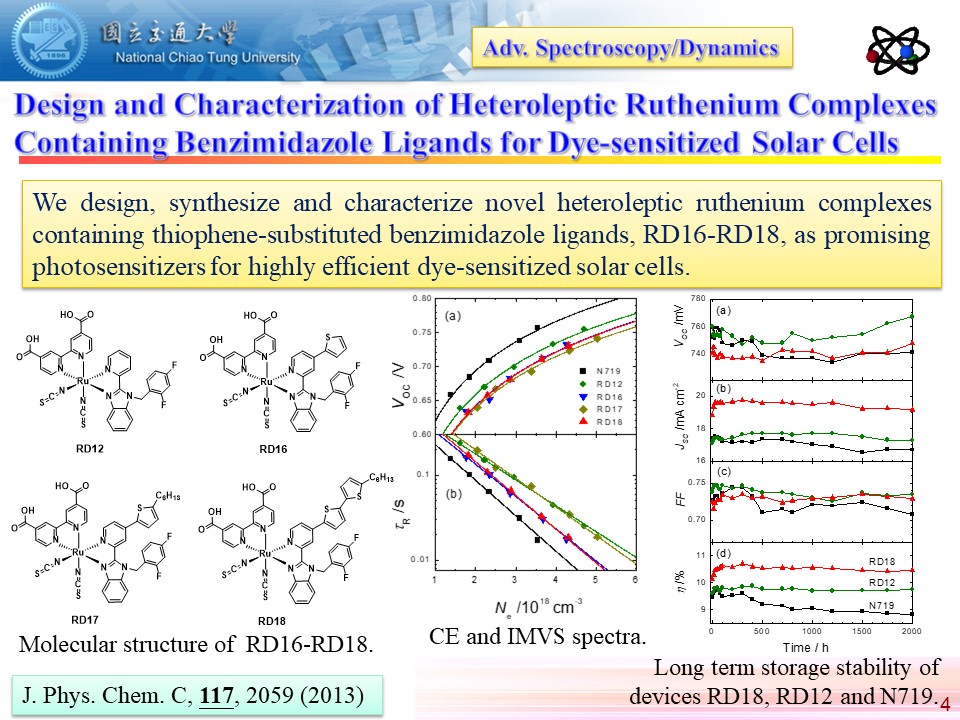





Effects of Hydrogen Bonding on Internal Conversion of GFP-like Chromophores. I. The para-Amino Systems

To understand the effects of solvent−solute hydrogen bonding (SSHB) on the excited-state dynamics of two GFP-like chromophores, we have determined the quantum yields of fluorescence for the isomerization Z→E (ΦZE) and investigated the fs fluorescence and transient absorption spectra in selected solvents. The behavior in aprotic solvents indicates that the E−Z photo-isomerization adopts a one-bond-flip mechanism through τ torsion to form a perpendicular species to the ground state. In conjunction with the solvent-independent rapid kinetics for the fluorescence decay and the solvent-dependent slow kinetics for the ground-state recovery, we conclude that the SSHB modifies the potential energy surface for the τ torsion in a way that the internal conversion occurs with a τ torsion angle smaller than 90°.
* G. J. Huang, C. W. Cheng, H. Y. Hsu, C. Prabhakar, Y. P. Lee, J. S. Yang, E. W.-G. Diau, “Effects of Hydrogen Bonding on Internal Conversion of GFP-like Chromophores. I. The para-Amino Systems”, J. Phys. Chem. B 117, 2695 (2013).
Effects of Hydrogen Bonding on Internal Conversion of GFP-like Chromophores. II. The meta-Amino Systems

To rationalize the efficient quenching of the fluorescence and the Z→E photoisomerization of m-ABDI in protic solvents, the femtosecond time-resolved fluorescence and transient absorption spectra of m-ABDI in select solvents were determined. In aprotic solvents, the fluorescence decay lifetimes are consistent with those of transient absorption data. In protic solvents, the fluorescence decays exhibited a biexponential nature. The IR TA results indicated the formation of an intermediate to diminish significantly the barrier of the torsion and induce a new competing reaction pathway. The proposed mechanism suggests the efficient fluorescence quenching and the diminished yield for Z→E photoisomerization. The new pathway is likely associated with excited-state proton transfer from the solvent to m-ABDI.
* C. W. Cheng, G. J. Huang, H. Y. Hsu, C. Prabhakar, Y. P. Lee, J. S. Yang, E. W.-G. Diau, “Effects of Hydrogen Bonding on Internal Conversion of GFP-like Chromophores. II. The meta-Amino Systems”, J. Phys. Chem. B 117, 2705 (2013).
Electron Injection and Charge Recombination Kinetics on Performance of Porphyrin-Sensitized Solar Cells: Effects of 4-tert-Butylpyridine Additive

The effects of the 4-tert-butylpyridine (TBP) additive in the electrolyte on photovoltaic performance of two porphyrin sensitizers (YD12 and YD12CN) were examined. Addition of TBP increased the power conversion efficiencies for YD12 (from 6.2% to 8.5%) but it led to a significant reduction for YD12CN (from 5.8% to 4.5%); Based on measurements of temporally resolved photoelectric transients of the devices and femtosecond fluorescence decays of thin-film samples, the poor performance of the YD12CN device in the presence of TBP can be understood as being due to the enhanced charge recombination, decreased electron injection, and a lesser extent of inhibition of the intermolecular energy transfer.
Y.-C. Chang, H.-P. Wu, N. M. Reddy, H.-W. Lee, H.-P. Lu, C.-Y. Yeh and E. W.-G. Diau, “Electron Injection and Charge Recombination Kinetics on Performance of Porphyrin-Sensitized Solar Cells: Effects of 4-tert-Butylpyridine Additive”, Phys. Chem. Chem. Phys 15, 4651-4655 (2013).
Design and Characterization of Heteroleptic Ruthenium Complexes Containing Benzimidazole Ligands for Dye-sensitized Solar Cells

We report herein the design, synthesis and characterization of novel ruthenium complexes (RD16-RD18) containing thiophene-substituted benzimidazole ligands, with the molecular structures modified based on a fluoro-substituted Ru complex (RD12) as promising photosensitizers for highly efficient dye-sensitized solar cells. Measurements of CE and IMVS indicate that thiophene substitution shifts downward the TiO2 potential and accelerates charge recombination, but inclusion of a long hexyl chain on the thiophene moiety retards charge recombination to account for the variation of VOC in the series. Only ~2 % performance degradation was observed for both RD12 and RD18 devices, reflecting their excellent durability for future commercialization.
* W.-K. Huang, H.-P. Wu, P.-L. Lin and E. W.-G. Diau, “Design and Characterization of Heteroleptic Ruthenium Complexes Containing Benzimidazole Ligands for Dye-sensitized Solar Cells: The Effect of Thiophene and Alkyl Substituents on Photovoltaic Performance”, J. Phys. Chem. C, 117, 2059 (2013)
Anatase Titania Single Crystals with Octahedron-Like Morphology for Dye-Sensitized Solar Cells

利用簡單的水熱合成法-由異丙醇鈦 (TTIP) 當作前驅物,三乙醇胺 (TEOA) 當作嵌合劑,在含有二乙胺 (EDA) 的水溶液中進行水解與縮合反應,藉由水熱溫度與時間的調控,可以產生不同尺寸(30 至 400 奈米)的類八面體銳鈦礦二氧化鈦奈米晶體(HD1 – HD5)。利用 30 奈米 (HD1) 之奈米晶體作為元件中的主動層,再以 300 奈米 (HD5) 之奈米晶體作為元件中的散射層,組裝成以 N719 為染料之染料敏化太陽能電池可以達到 10.2 % 之光電轉換效能,勝過以傳統的奈米粒子 (NP) 所製作之電池元件。此 HD 系列之電池元件呈現出較高的開路電壓 (VOC),這是因為單顆晶體的結構使TiO2的電位更負,電子的傳遞更為迅速所致。
* J.-W. Shiu, C.-M. Lan, Y.-C. Chang, H.-P. Wu, W.-K. Huang and E. W.-G. Diau, “Size-Controlled Anatase Titania Single Crystals with Octahedron-Like Morphology for Dye-Sensitized Solar Cells”, ACS Nano, 6, 10860 (2012).
Hybrid Titania Photoanodes with a Nanostructured Multi-layer Configuration for Highly Efficient Dye-sensitized Solar Cells


To construct a hybrid photoanode containing nanoparticles and nanorods of varied size in a multi-layer (ML) configuration for DSSC, the essence of our ML design is a bi-layer system with additional layers of nanorods of well controlled size inserted between the transparent and the scattering layers to enhance the light-harvesting capability for photosensitizers with small absorptivity, such as Z907. The advantages of one-dimensional nanorods with an improved electron-transport property and an upward shift of the potential band edge; a favorable ML configuration was constructed to have a cascade potential feature for feasible electron transport from long nanorods, normal nanorods to small nanoparticles. Based on the ML system reported herein, we demonstrate how the performance of a Z907 device is improved to attain ~10 %, which is a milestone for its future commercialization.
* H.-P. Wu, C.-M. Lan, J.-Y. Hu, W.-K. Huang, J.-W. Shiu, Z.-J. Lan, C.-M. Tsai, C.-H. Su and E. W.-G. Diau, “Hybrid Titania Photoanodes with a Nanostructured Multi-Layer Configuration for Highly Efficient Dye-sensitized Solar Cells”, J. Phys. Chem. Lett., 4, 1570 (2013).